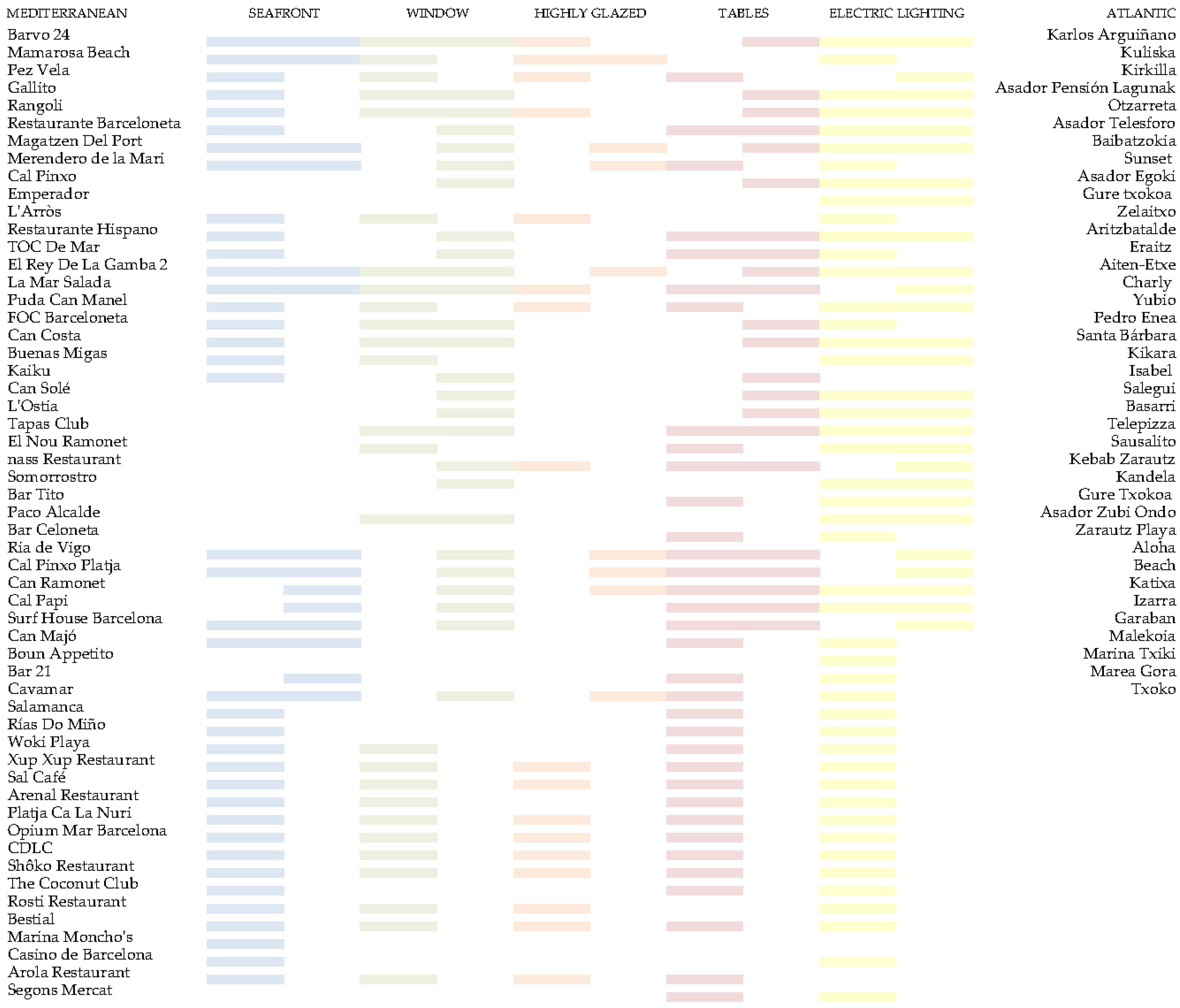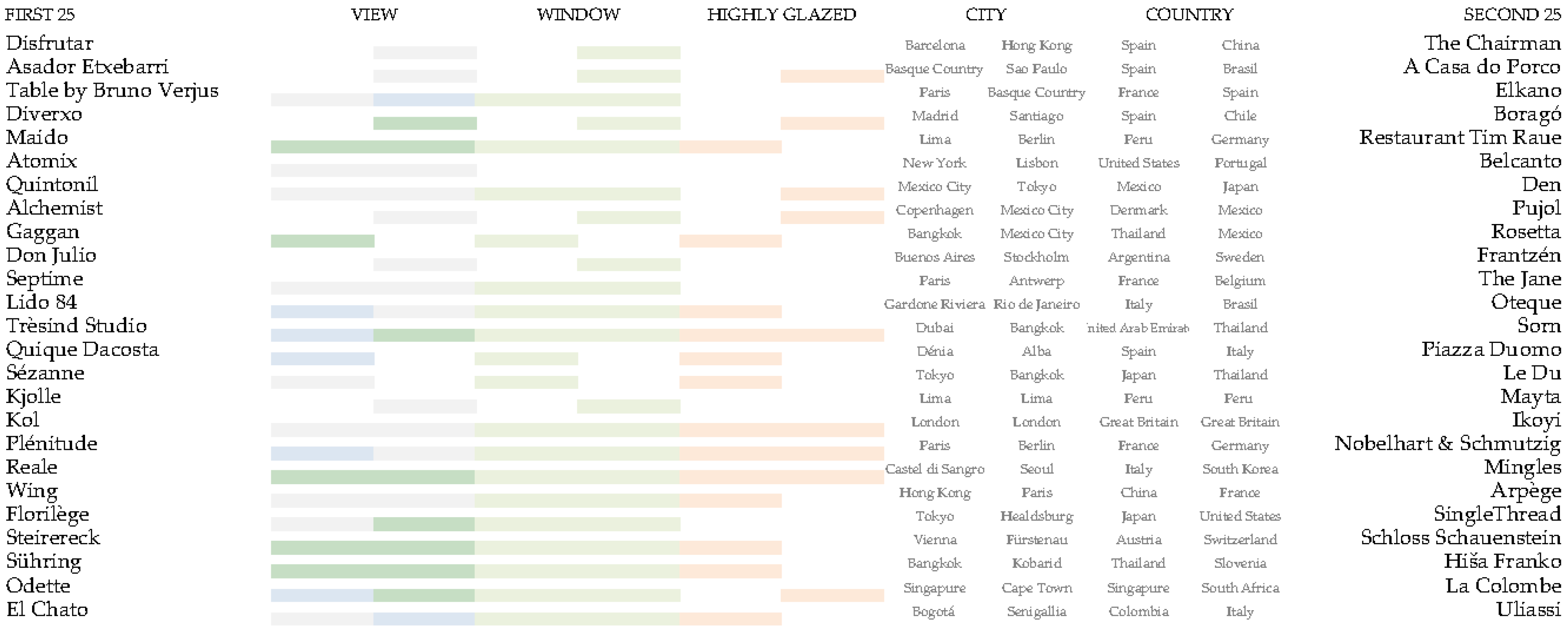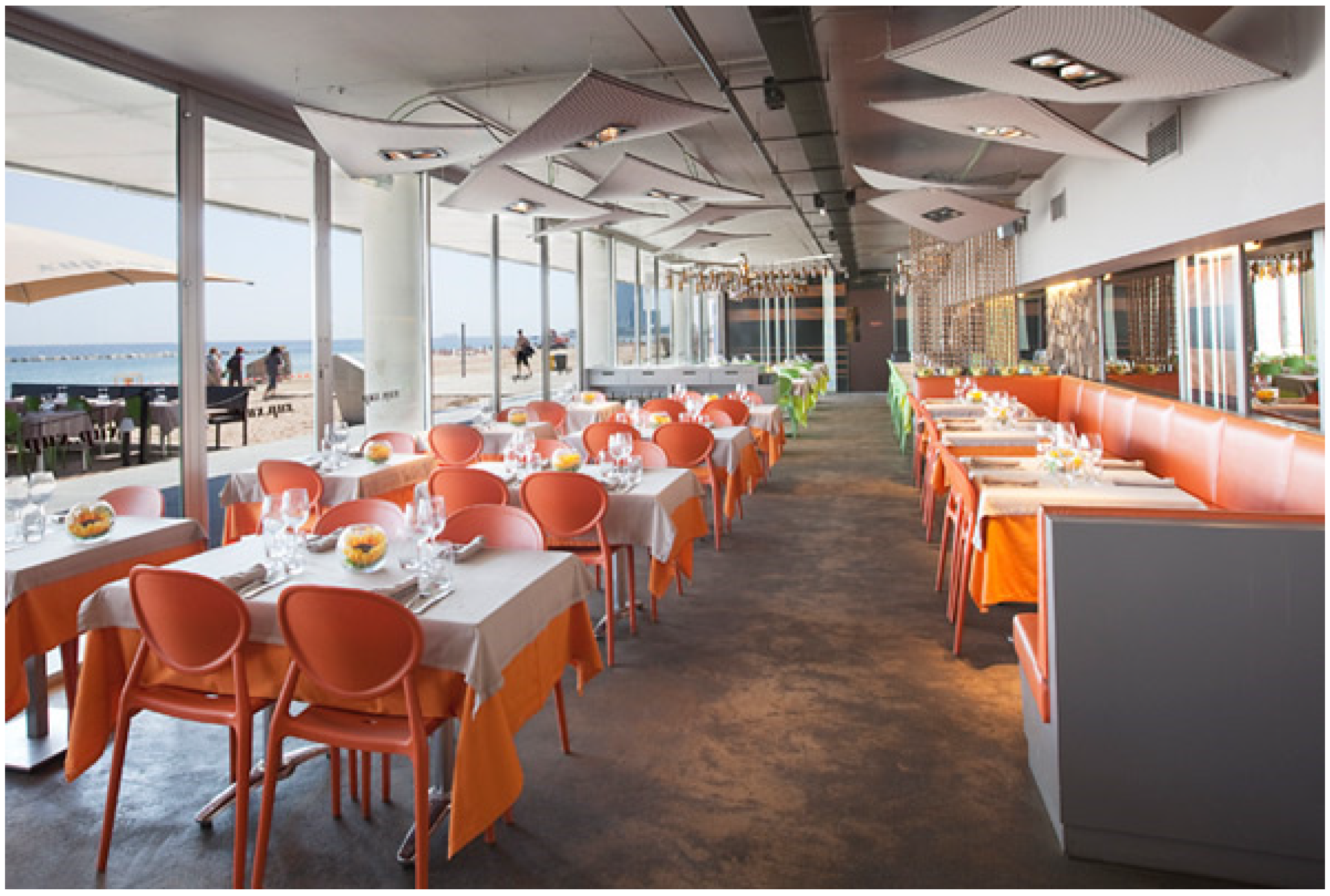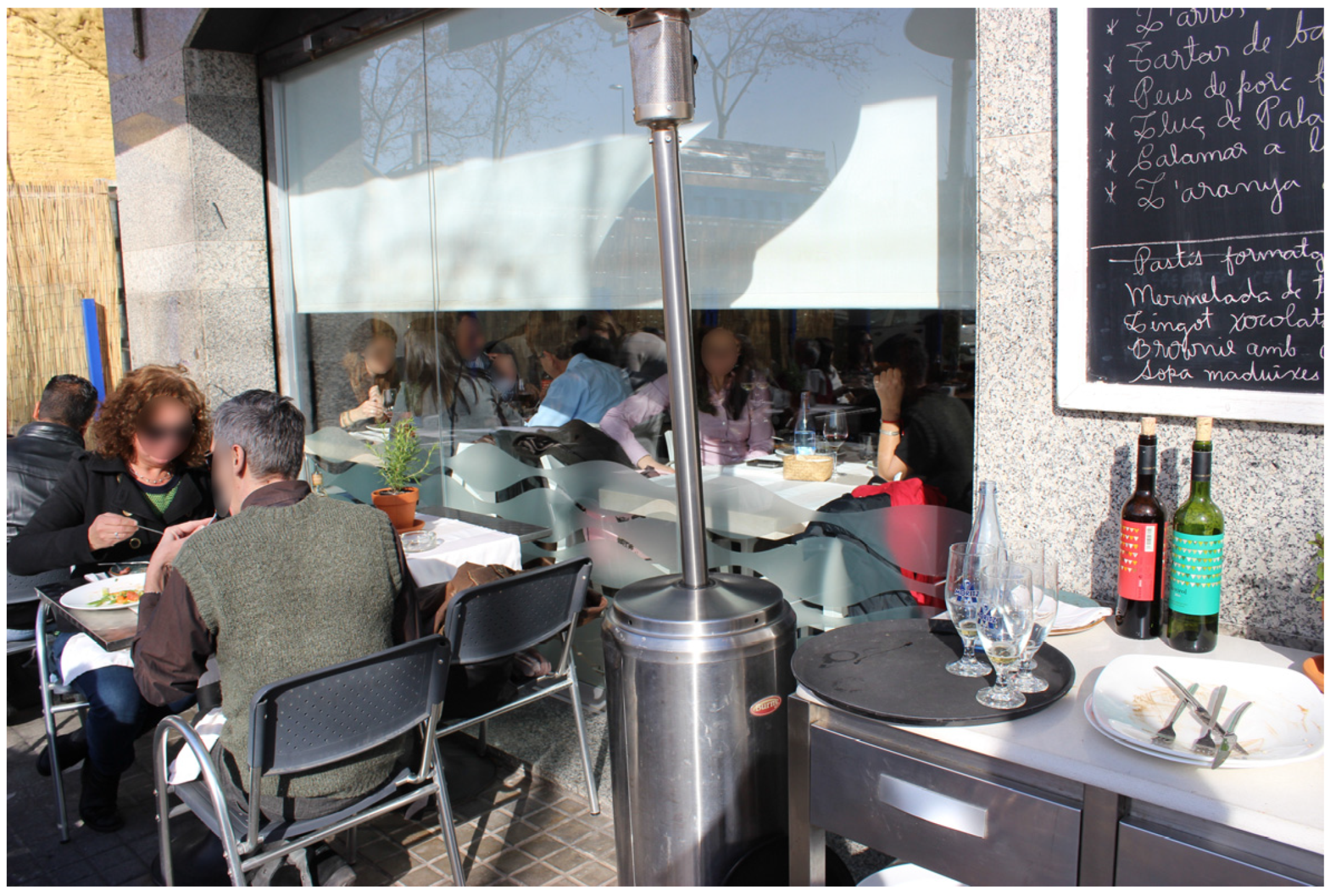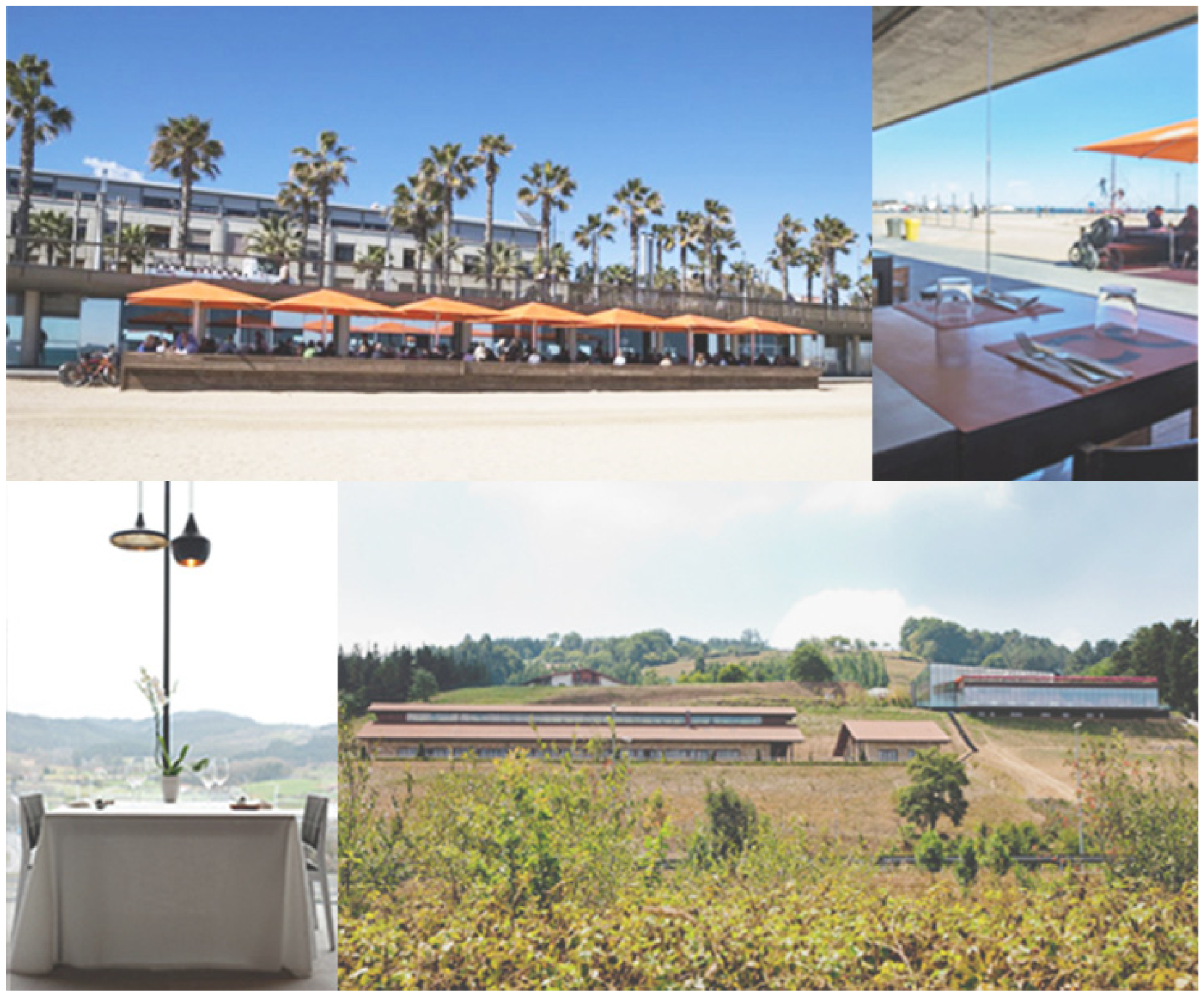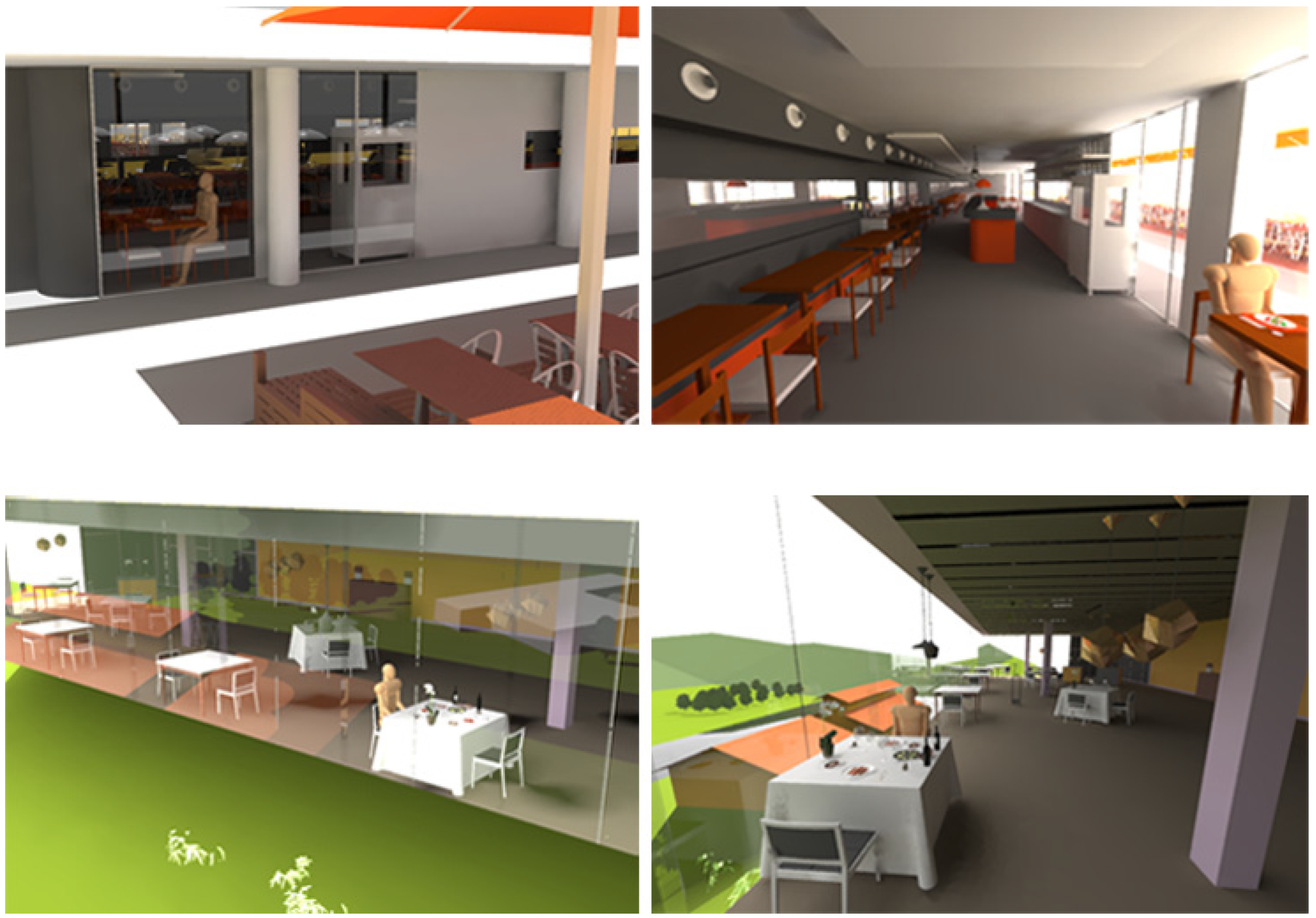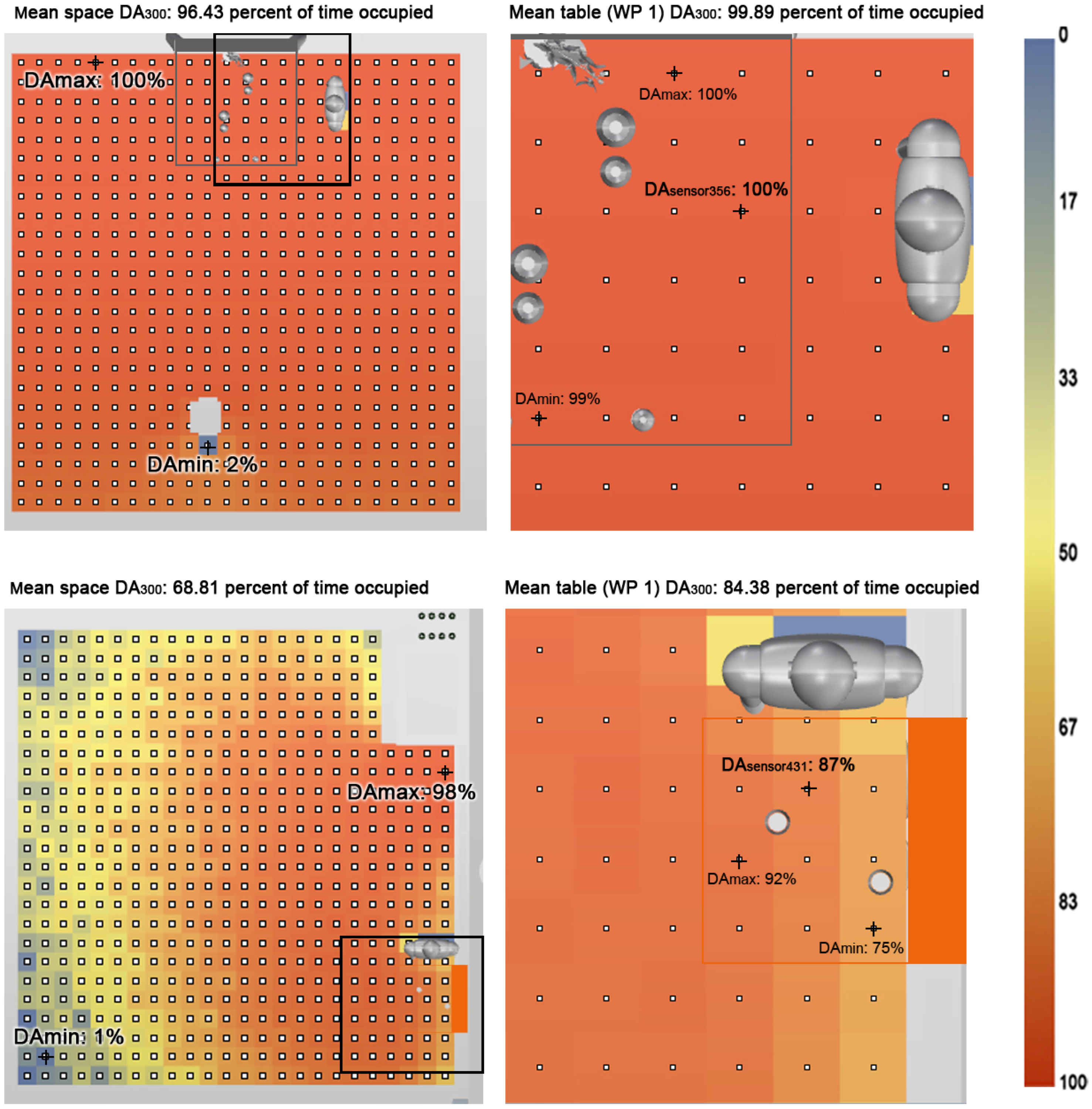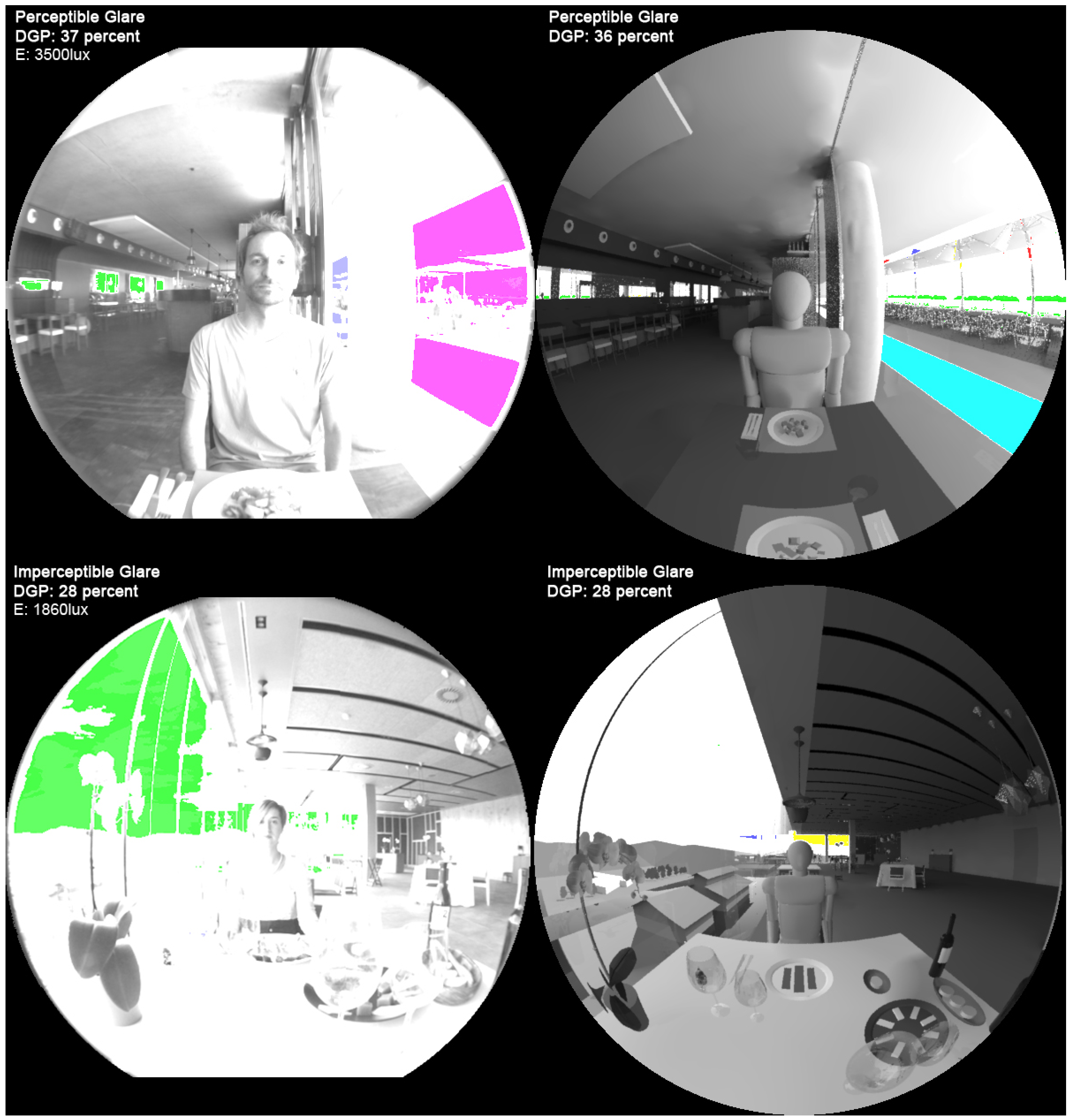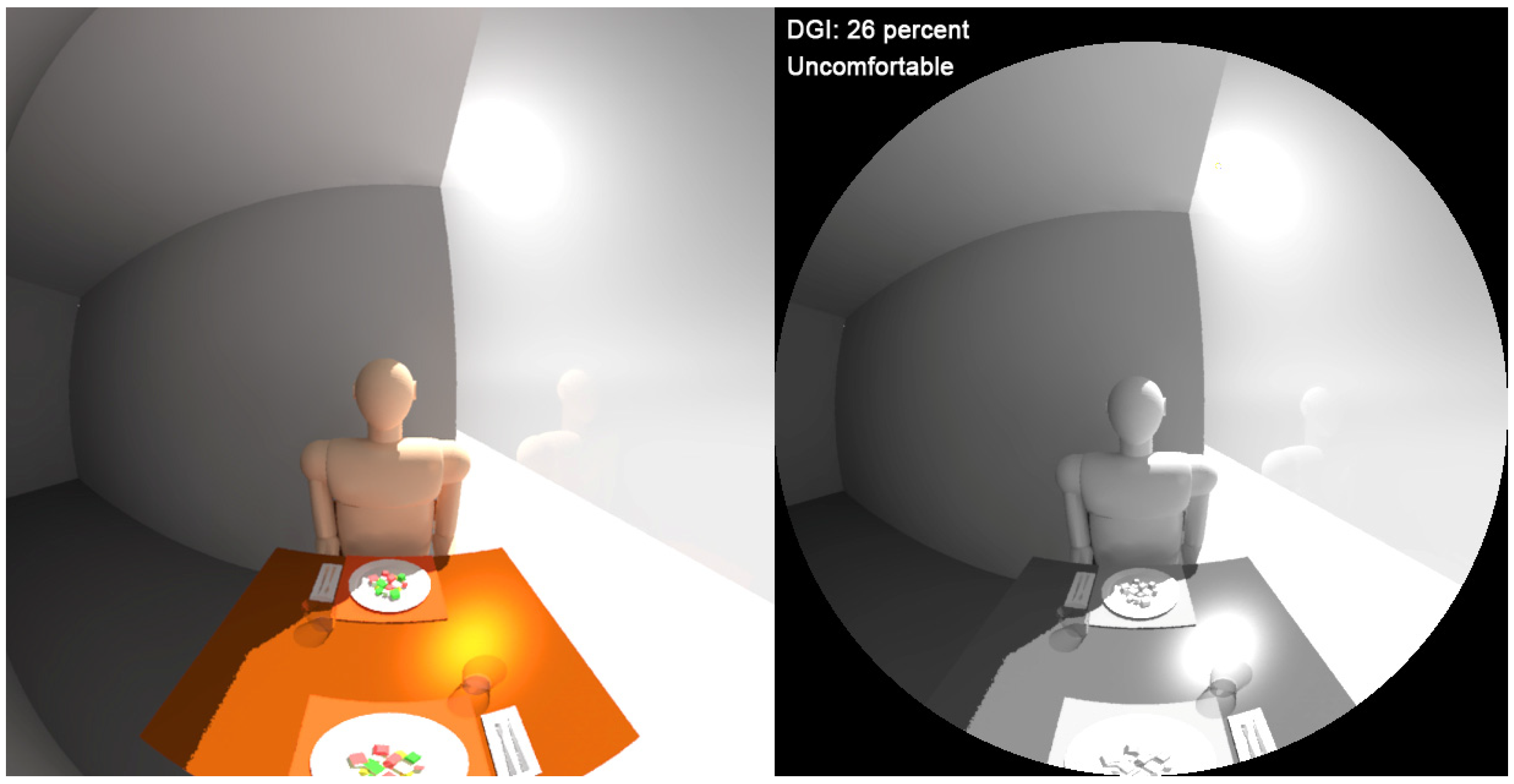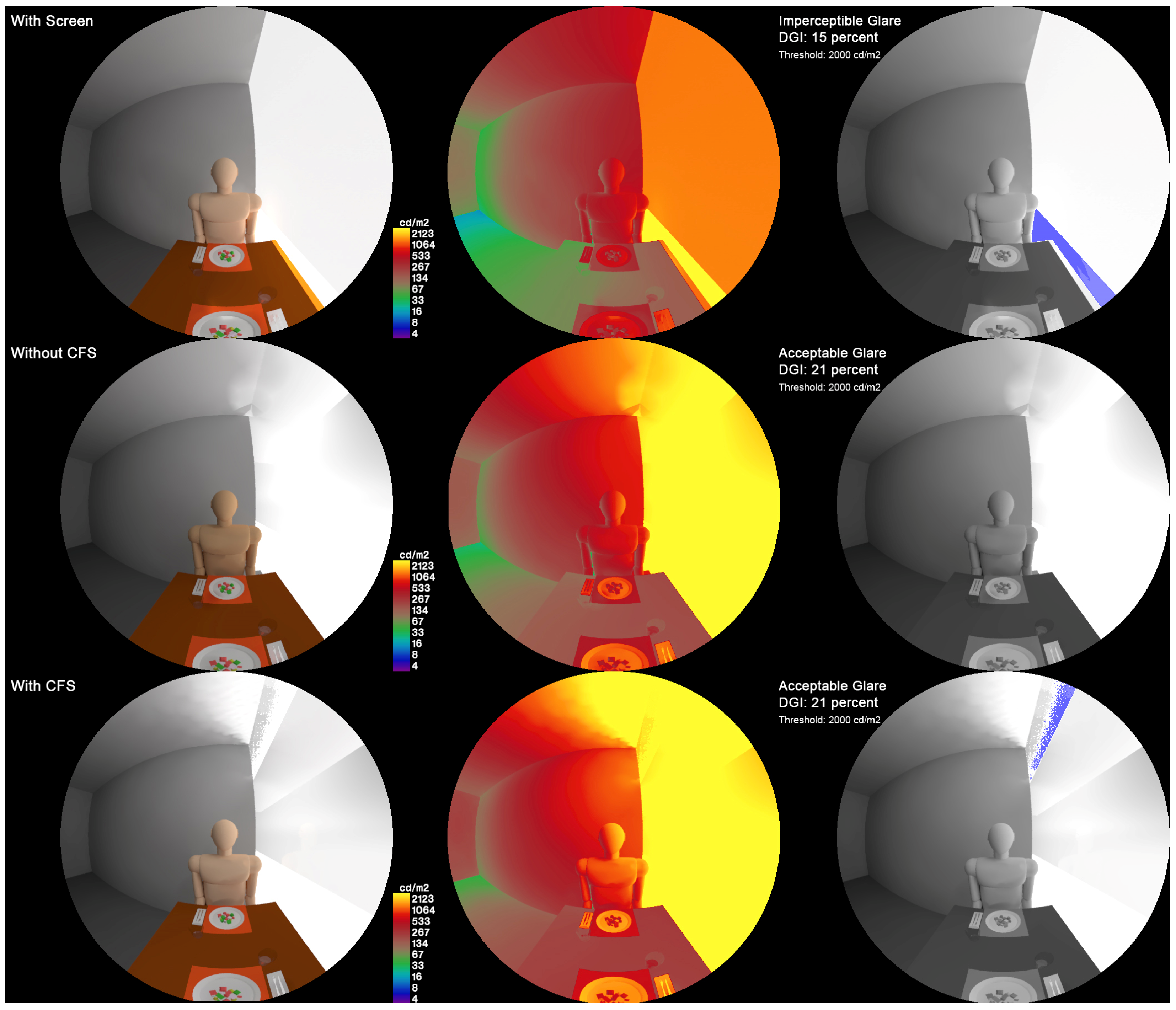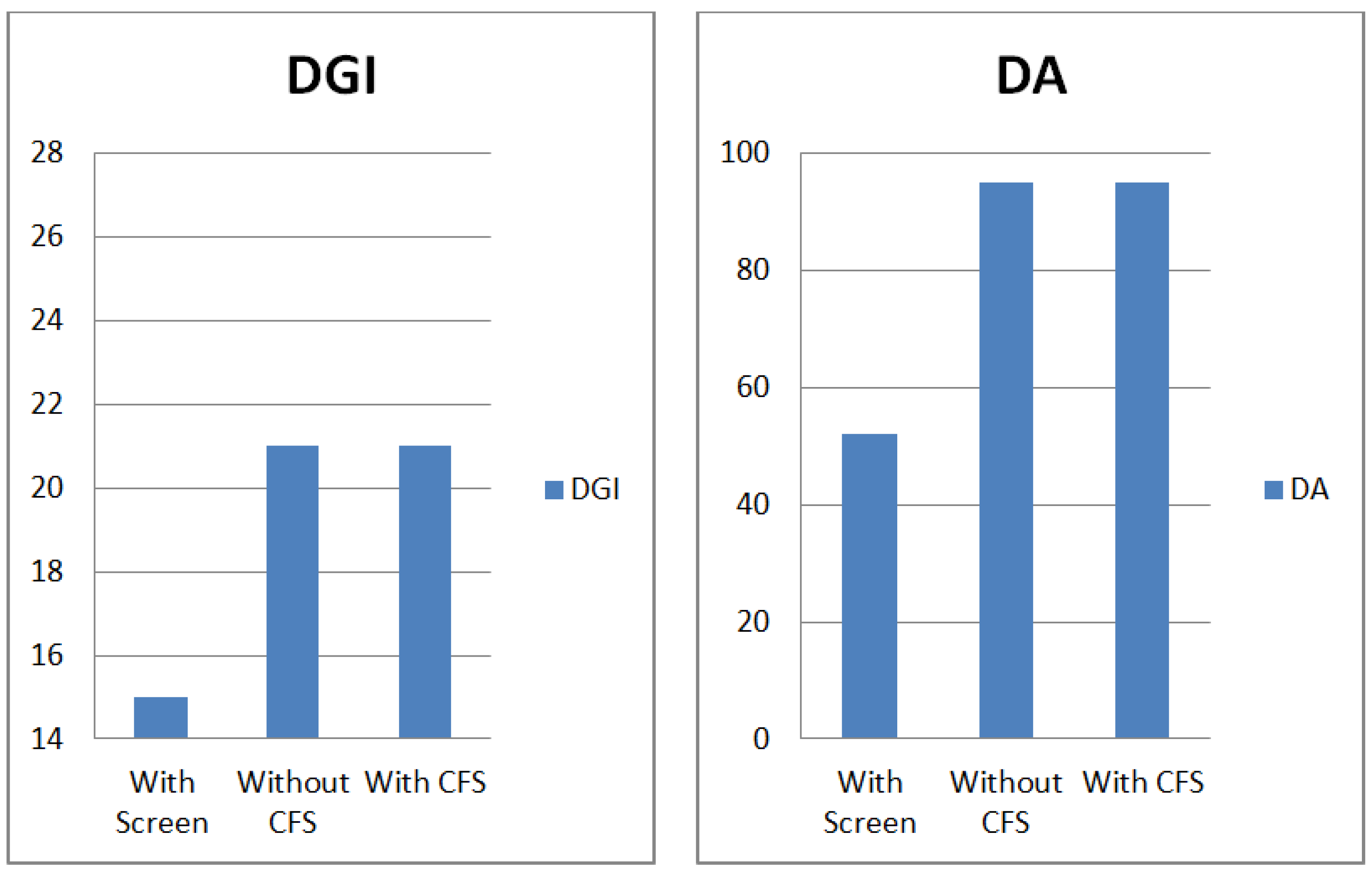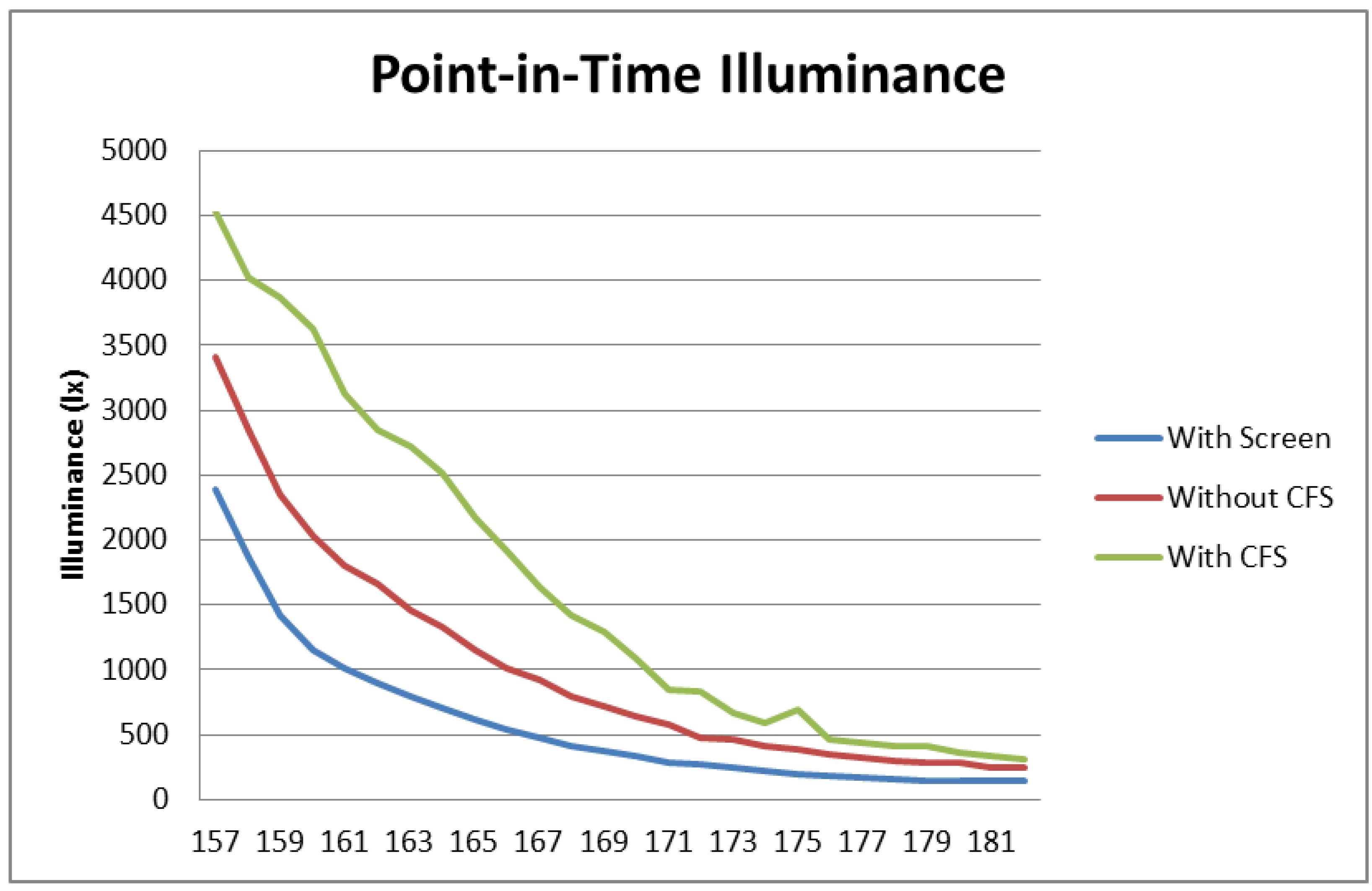1. Introduction
According to the studies of the Building Performance Institute Europe (BPIE) [
1], the hotel and restaurant building stock in Europe is around 11% within non-residential floor space, which is around 25%. This means that the hotel and restaurant floor space is 2.64 billion m
2, with the corresponding CO
2 emissions; if Europe has around 1.8 T CO
2 emissions per useful floor area, this is equivalent to around 4.752 billion T CO
2 emissions. On the other hand, buildings related to the service industry account for 13% of final energy consumption by sector in the EU (2009) and in the EU 27, and together with Switzerland and Norway, the final energy consumption is 146 Mtoe. Furthermore, the final energy use in hotels and restaurants is 12%, which is around 17.52 Mtoe. However, hotels and restaurants in non-residential buildings, including hospitals, have a very high specific energy use of around 300 kWh/m
2. In Spain there are around 0.05 billion m
2 of hotels and restaurants; according to studies by the Institute for the Diversification and Saving of Energy (IDAE) [
2], 12.5% of final energy consumption is from services, and 9% is from hotels and restaurants. Furthermore, although the last decade has seen a decline, over the last 4 years, the restaurants in Spain have increased by up to 277, 539 bars and restaurants [
3], with a subsequent increase in floor space and energy consumption.
Shi and Yit Lin Chew showed that the energy consumption of lighting in buildings is a major contributor to carbon emissions, often estimated at 20–40% of the total building energy consumption [
4]. Moreover, the lighting consumption in restaurants in Spain is around 11% [
5]; nevertheless, another study shows that the lighting consumption of restaurants is around 28%, 58.7 kWh/m
2 [
6].
Regarding advanced daylighting systems, in the review on sustainable design of renewable energy systems conducted by Shi and Yit Lin Chew, they mention that with prismatic glazing, higher efficiency seasonal shading can be realised. They showed that they are suitable for vertical, south-facing windows or facade elements, preferably in applications that do not need a free view, for example, high windows or windows in factories and sports halls. Furthermore, they explained that the direct radiation received on a vertical south-façade is reduced to 10% on clear summer days, while 90% is transmitted on clear winter days [
4,
7].
In the study of “Energy Efficient Lighting Strategies in Buildings” [
8], Tsangrassoulis and Li mentioned that innovative daylighting devices can effectively block the solar heat gain but still allow certain amounts of daylight to penetrate into the building. Furthermore, they mentioned that the literature shows that the introduction of daylight-linked controls can reduce the lighting energy consumption by up to 60%, while values ranging between 20 and 40% represent, on average, a more realistic target, depending on the use and shape of the building and its time schedule. Otherwise, another study shows that the electricity demand of the advanced system is 32% less than the reference one [
9]. On the other hand, another study demonstrated that the combined use of the integrated system can achieve a satisfactory relatively uniform distribution of daylight over about 90% of the desktop area, within an illuminance range of 300–500 lx for most of the working hours throughout the year [
10].
Analysing the literature, we can see that there are few studies on daylighting performance in hotels and restaurants. However, we consider that these advanced daylighting systems can be extrapolated to this sector. Although this hotel industry sector does not have the highest floor space, there is an opportunity to reduce the high specific-energy use, which is particularly related to this sector. Furthermore, many establishments are aging and, consequently, have high energy consumption and need to be refurbished. However, in recent years, the catering sector has evolved considerably and has become one of the main job generators [
6]. In this context, this paper discusses the use of daylighting and visual comfort to enhance the quality of indoor atmospheres, considering building skins, particularly at restaurants with large glazed façades [
11].
In order to implement advanced daylighting systems at restaurants, the first step was considered to be the analysis of the design of shading systems. Therefore, this article started by assessing the composition of restaurant façades to determine the reference layout and point of view next to the façade. With this aim in mind, 94 restaurants in two places with highly valued seascapes were studied; one specific neighbourhood of Barcelona and one town in the Basque Country. Following this, two real restaurants were selected in order to simulate and evaluate their shading systems. Subsequently, a virtual restaurant prototype with a highly glazed façade and three different shading systems was built in order to simulate the daylight performance of each case [
12]. A different type of solar protection is considered for assessment because each case provides a very different light environment and electric lighting demand. Some solutions are able to achieve daylight penetration with comfortable light perception and that keeps out of view [
13,
14].
2. Daylighting and Restaurant’s Façade
This study began by studying the façades of restaurants and the indoor environments that made up the different types of façades with exterior views. For this purpose, 94 restaurants in Spain were selected [
15]. If we consider that there are 277, 539 restaurants in Spain [
3], we can estimate the error of the selected sample of 94 restaurants. Hence, we will use the following equation, Equation (1), to estimate the proportion with standard distribution [
16]:
where
Z = confidence level;
α = significance level;
p = estimated proportion of the population having the characteristic of interest;
n = sample size.
Therefore, it considered a 95% of confidence level with 0.05 significance level, 1.96 Z value, and 0.5 estimated proportion, maximising the sample size. Thus, for 94 samples, the error margin value is 10%.
According to the Köppen–Geiger climate classification in Spain, there are two different climates, Mediterranean and Atlantic. Hence, in each climate, restaurants of two places with a seafront and prominent culinary culture were studied: Barcelona with a Mediterranean climate and Zarautz in the Basque Country with an Atlantic climate.
In the Mediterranean climate, as a sunny climate, the problems with solar radiation and glare increase. Therefore, according to the assessment of restaurants in Barcelona, 56 restaurants were studied in Barcelona (Spain); almost all cases (93%) have a window with outside views, almost half the cases (43%) have a highly glazed façade, and almost all new or refurbished cases (94%) have a highly glazed façade (See
Figure 1). There are problems with highly glazed façades and with solar protections in order to maintain the light and outside view [
15]. The most glazed façades have a large piece of glass, only 20% of highly glazed facades are split. Most of the split façades are divided into three parts, not all of which have a contemporary design.
Moreover, these segmentations mostly follow the same pattern; top, centre, and bottom. Accordingly, this design strategy responds to the required passive window functions: outside connection, lighting, and also ventilation [
17].
On the other hand, Zarautz is located on the Atlantic coast, and in recent years, it has become one of the municipalities with the most restaurants per square metre. In this area, similar patterns are detected, given the fact that 26% of all the restaurant facades analysed are highly glazed. Of these, 80% are located on the seafront, and furthermore, 75% are on the ground floor. There are fewer restaurants than in La Barceloneta, but the glazed façades tend to be non-split [
15].
In real-world restaurant scope, there are many distinctions or awards that classify these restaurants. One of these rankings is restaurants with the best views in the world; and one of them could be from Silver Spoon, titled “23 of the World’s Best Restaurants with a View” [
18]. Within this ranking, the landscapes of these views mainly are related to water, related to greenery, and related to urban environments. As one colour predominates for the most part of the scenes, more than 50%, in the present study, these views were named blue, green, and grey. Thus, 52% of those views are blue, 30% are grey, and 17% are green. In addition, the “World’s 50 Best Restaurants” ranking of 2024 was studied. In the same way, the blue, green, or grey location refers to more than 50% of each colour in the view photograph from the window and related to its landscape. The photographs were collected by online resources. As shown in
Figure 2, 82% have a window; from those, 44% are a highly glazed façade, and 54% have a grey view, 28% green, and 18% blue. In addition, the best restaurant in Spain is in Barcelona, and the second best is in the Basque Country. In addition, of the first four places, three are from Spain, and it is the country with the most award-winning restaurants, with four award-winning restaurants, along with three other countries, France, Thailand, and Italy (See
Figure 2).
In the previous studies, several measurements and HDR photographs were taken at monitored restaurants [
17]. In those studies, the results showed that different window systems can improve light perception, encourage people to think the outside view is desirable [
19,
20], and control outdoor large luminous surfaces. The outside view is considered as another plane to assess, but the requirements of light perception of this plane are different. According to the surveys that were carried out, the tolerance of outdoor luminance is higher because the outside luminance range is higher, and the level of attention and accuracy is lower as well. On the other hand, the overhang solar protection can allow for an outside view without obstructions, and its position can permit CFS integration. Furthermore, the inside colour atmosphere should be integrated with the façade system because although the light level is enough, the inside darker perception could create a gloomy atmosphere.
It is difficult to control daylighting in these highly glazed façades (See
Figure 3), as it is extremely difficult to block direct solar radiation. A screen is often used to avoid direct daylighting, but this often obstructs the outside view. Moreover, the large screen does not make it possible to redirect part of the light inward. Furthermore, with the highly glazed façade, the exterior large luminous surfaces are visible in the field of vision. These surfaces, with a large solid angle, tend to increase glare probability. A screen is often used in this case too, yet again obstructing the outside view (see
Figure 4). In this context, the glazed façade design is extremely important in order to provide an accurate interior daylight level and balanced visual perception with an outdoor view [
21,
22].
In this context, we have considered that it is important to test different kinds of shading systems for highly glazed façades. Following this, the limited screen solution is going to be compared with other solar protection systems. Those are a simple overhang system and an overhang integrated with a prismatic film CFS. Therefore, they are compared with the screen option to know the possible advantages of them.
3. Materials and Methods
Simulation methodology was selected to try out different shading systems for highly glazed façades. The simulation tools used were based on Radiance [
23,
24]. Three-Phase Method of Radiance [
25] and Radiance for Rhinoceros were used to calculate the daylight results [
26,
27].
First, the façades of different restaurants in Spain were studied. According to this study, these results were found: 56% are placed at seafront; 55% have window with outdoor view; 35% have highly glazed façade; and 60% have tables next to the façade. Of all the restaurants studied, two restaurants were chosen in each climate: one in the Mediterranean, in Barcelona, and other in the Atlantic, in Zarautz (Basque Country). These two restaurants have the characteristics mentioned: there are placed in valued landscape; they have highly glazed window with value outdoor view; and they have tables next to the window. After, those two real restaurants were tested, taking into account light level and light perception. Thus, those two real restaurants were modelled and the results calibrated. The strategy of building a model of the main surfaces and colours was chosen. Finally, having adjusted parameters, a virtual restaurant prototype was proposed to determine more accurate simulation and light performance according to three kinds of shading systems: a screen, a simple overhang, and an overhang integrated with a prismatic film complex fenestration system. The strategy of building this model was first defining the façade size that contributes to table and indoor space next to it and, after, choosing main surfaces and colours.
Therefore, the method was based on testing light performance, so two parameters were selected for this purpose: light level and light perception. The daylight glare index (DGI) was used to assess light perception, and daylight autonomy (DA) was used to assess light level. The daylight glare probability (DGP) was also useful for testing the real two restaurants with less indoor light level.
The DGI of real and simulated pictures were calculated by Evalglare [
28,
29] with the threshold method as 2000 cd/m
2 because the amount of outside view was large. On the one hand, the DA of simple façades was calculated by Radiance for Rhinoceros. Among all the parameters, two stood out: number of reflections and ambient divisions. The selected numbers were 2 reflections and 1000 ambient divisions. On the other hand, the Three-Phase Method of Radiance was used for calculating DA of complex fenestration systems. In this case, the two parameters were 4 reflections and 1000 ambient divisions. Following this, its results were uploaded to Rhinoceros to display graphically the light distribution. In
Figure 5 there is a diagram to summarise the 8 steps of the methodology carried out, identified by colours.
5. Results
First of all, the results of real restaurants show that although the Atlantic restaurant, Azurmendi, is north oriented, and the DA (almost 96) is higher than the DA for the Mediterranean restaurant, Sal Café (almost 49) (see
Figure 10). Although the façade of Sal Café is south-east oriented, it has a large overhang and a smaller glass façade, which reduces the DA. However, the DGP for the Sal Café is higher due to the fact that for the viewpoint evaluated, there are outdoor surfaces with very high luminance. Despite the diffuse luminous perception of the Atlantic climate restaurant, the incoming vertical illuminance of the viewpoint evaluated is lower in comparison to the Mediterranean one, with high contrast perception and shadow but with high incoming vertical illuminance (see
Figure 11). Therefore, depending on the type of shading system selected, this could reduce the daylight autonomy.
Otherwise, the Mediterranean climate has glare problems, so solar protection would be necessary. According to the virtual prototype restaurant without a shading system in the selected viewpoint, there is intolerable DGP (see
Figure 12). Therefore, although the overhang reduces the daylight autonomy, it also reduces the daylight glare probability, which is very important in this climate. Therefore, the glazed area, the orientation, and the climate are determinant.
On the other hand, the results of virtual prototype restaurant are explained according to the above-mentioned three different solar protections. The results of the façade systems with the screen are 52% for DA and 15% for DGI, which is imperceptible. However, the screen obstructs the overall outdoor view; for the day studied, the screen needs to be lowered to table height.
The results of the façade systems with an overhang show that the overhang shading system, with or without a CFS, provides similar DA because the DA for both systems is very frequently above 300 lx (see
Figure 13). Nevertheless, the results for the point-in-time 27 July at 11:00 illuminances of an overhang with CFSs are higher and slightly better distributed in space than the overhang without a CFS, as explained in the discussion section below. With reference to the DGI results, the façade system with an overhang and CFS is almost the same as the façade system with an overhang but without a CFS, with 21% acceptable. In both cases, the luminance threshold was 2000 cd/m
2 (see
Figure 14).
6. Discussion and Future Work
According to the DGI results, if the same threshold of 2000 cd/m
2 is considered for all, between similar scenes as a highly glazed façade system without a CFS or with a CFS, there is not a huge difference as the shading system with an overhang. However, a highly glazed façade system with a screen has considerably less DGI but without a good outdoor view (see
Figure 15). The DGP is more sensitive to incoming vertical illuminance; therefore, solar protection with a CFS has slightly more DGP.
With regard to the DA results for the Three-Phase Method with an overhang, the window should be divided into different parts to calculate more accurate DA results because otherwise, the results are slightly overestimated. The DAs of overhang shading systems are similar because both systems provide many hours above 300 lx. However, the light level could be different; the results of the point-in-time (27 July at 11:00) illuminances for the overhang system with a CFS is higher and slightly better distributed in space than the overhang system without a CFS. The prismatic film complex fenestration system with direct solar light provides a better illuminance level and distribution (see
Figure 16). Therefore, taking into account the accurate complex fenestration system, the balance between light level and light perception could be better. It should be added that the overhang may provide a darker background so that warm colours inside could create a more luminous environment with better visual comfort [
17].
In hotels and restaurants, solar protection is necessary, as an outdoor view is in much demand. With reference to
Figure 1, according to the restaurants studied, despite the fact that most of them have windows, 77% use electric lighting. A correct shading system could increase visual comfort and reduce electric lighting consumption [
5]. According to daylight autonomy in the selected time schedule, from 11:00 solar time to 17:00, there are many hours when electric lighting is not necessary but is actually used. Accurate daylight penetration could contribute to reduce the aforementioned energy consumption by around 28% [
6]. Furthermore, visual comfort could improve considerably.
For future work, it could be interesting to improve the simulations by obtaining the DA with the Five-Phase Method with a divided glazed façade and integrated control systems. Therefore, savings in the use of electric lighting could be added. Furthermore, one could add the contribution of colour, especially warm colours in an indoor environment, as the use of electric lighting sometimes seems to make the indoor environment warmer, evidencing the relationship with Kruithof’s curves [
38]. On the other hand, it may be necessary to validate the results with measurements and, finally, to calculate and measure the light ambient and the energy savings of restaurants with advanced daylighting systems.
7. Conclusions
The hotel industry in Spain has been shown to be a significant sector with a prominent culinary culture. Hotels and restaurants account for almost half the service buildings, while in Europe, it is around half. Consequently, the hotel industry is a sector that lends itself to energy optimisation. Furthermore, in this area, light perception has considerable importance, as the outside view is in substantial demand. Therefore, it is considered that it could be interesting to implement advanced daylighting systems. Moreover, the tables next to the façade at restaurants have similar work planes as tables at offices.
In the previous study, it was detected that there are many restaurants with highly glazed façades: 43% in the Mediterranean climate case study and 26% in the Atlantic climate case study. In addition, in the “World’s 50 Best Restaurants” ranking of 2024, 44% of restaurants have highly glazed façades. However, there are visual comfort problems related to the shading system of these highly glazed façades; screens often have to be used. They are not very suitable because they reduce the daylight contribution and obstruct the outside view, which also increases electric lighting consumption. In the real restaurants modelled, the following was observed: the accurate design of the overhang could considerably change daylighting penetration; the direct component of daylight could create more shadows; and the high outdoor luminance affects light perception.
According to the cooperation of three different types of shading systems implemented at the virtual restaurant prototype, the screen provides (52%) almost half the DA of the façade system with an overhang (see
Figure 15). This shading system in the selected time schedule provides very high DA, which almost totals 95% (see
Figure 13). Moreover, if the overhang solution is positioned below, then it is possible to implement the prismatic film CFS above it, giving a higher illuminance level and better distributed daylight (see
Figure 16). Regarding the light perception of the three shading systems, the screen option has (15%) less DGI, which is imperceptible, than overhang systems (21%), which is acceptable. Nevertheless, although the CFS increases in a little glare perception, the overhang shading systems do not obstruct the outside view, and the light perception is acceptable.
In conclusion, on the one hand, it is recommended to study the facades and advanced shading system of hotel industry buildings, where not only is a high enough daylight level without glare necessary, but also the outside views can be appreciated well. On the other hand, it is recommended that the shading system integrated with lighting control systems of the highly glazed façade and indoor warm environment is accurately designed to use daylighting and reduce electric lighting consumption. Within the control systems, it is possible to study dynamic, hybrid, and adaptive shading systems. Consequently, the advanced daylighting systems can manage the light perception, achieving a balanced visual field with an outdoor connection.
